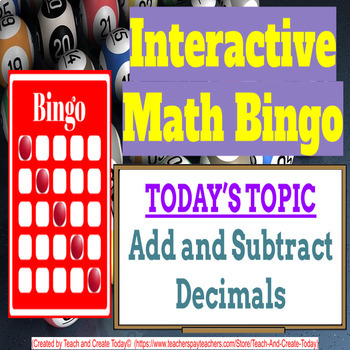4th Grade Math Game Bingo Activities SUPER BUNDLE 17 DIGITAL RESOURCES
- Zip
- Google Apps™

Products in this Bundle (17)
showing 1-5 of 17 products
Description
Add this Math Bingo Game to your fourth grade math lessons! This digital resource will be a hit with your 4th grade students!
Engage your fourth-grade students in a fun and interactive math activity with these Bingo games! These Google Slides activities allow students to practice their math skills in an enjoyable and engaging way. This resource is a great addition to any math lesson plan!
This Bundle gives you 17 different Bingo games to play to make math much more fun!!
This bundle includes:
1) Add Three Digit Numbers
2) Add Four Digit Numbers
3) Subtract Three Digit Numbers
4) Subtract Four Digit Numbers
5) Multiply One Digit by Three Digit Numbers
6) Multiply One Digit by Four Digit Numbers
7) Multiply Two Digit by Three Digit Numbers
8) Multiply Two Digit by Four Digit Numbers
9) Single Digit Division (No Remainder)
10) Single Digit Division (With Remainder)
11) Three Digit divided by One Digit (With Remainder)
12) Four Digit divided by One Digit (With Remainder)
13) Order Of Operations: Add and Subtract
14) Order Of Operations: Add, Subtract, and Multiply
15) Order Of Operations: Add, Subtract, Multiply, and Divide
16) Fractions: Add and Subtraction Mixed Numbers (Like Denominators)
17) Add and Subtract Decimals
- NO PREP NEEDED! These games are all set-up for you!
Make solving math equations really fun with these Interactive Bingo Activities!
Each Bingo game contains 25 equations to be solved. (Use as many as you need to!)
Your students draw their own Bingo board on paper. (4 x 4 is what I suggest, but you can do what you think is best!) Students fill up their board with the answers, shown to them, (but they don't know the equations!) The Bingo game reveals the equations, which the students solve! A Google Sheets file is included here with a list of all the equations and answers, to help keep you organized.
As the math equations appear on the Bingo balls, students have to solve the equation. They check their boards to see if they have the correct answer. If they do, they mark their boards just like a regular bingo game!
Full instructions are included with this product to help you get ready to play!
NOTE: The product you purchase here is a PDF, which comes with a link to the Google Slides file of the Interactive Activity and the Google Sheets so you can copy the files into your own Google Drive. This allows you to fully edit the files, in case you feel like adding anything!
For More Math Bingo Activities, Click Here:
FOR MORE CREATIVE AND ENGAGING RESOURCES, CHECK OUT THE TPT STORE:
Connect With Teach and Create Today© On:
WE SOMETIMES DO FUN GIVEAWAYS AND PROMOTIONS, SO COME FOLLOW ALONG!
Please feel free to reach out if you ever have any comments or questions about anything. I am always happy to help in any way that I can!
THANK YOU SO MUCH FOR YOUR SUPPORT! IT IS GREATLY APPRECIATED!
Teachers make the best creators!
-Teach and Create Today©





